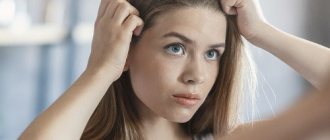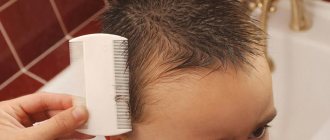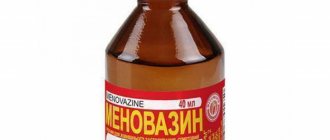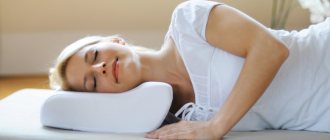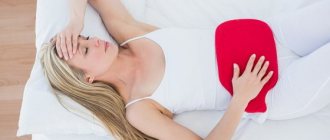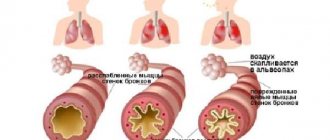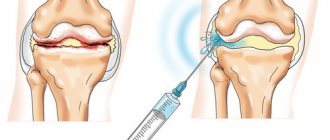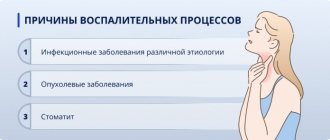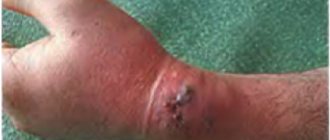Author: Pushkina Natalya Vladimirovna
, dermatovenerologist of the first category, practicing trichologist, member of the Union of Trichologists and the Eurasian Association of Trichologists, teacher at the Nautilus School of Trichology
Seborrheic dermatitis is a serious scalp condition. The scalp peels intensely, a person is constantly bothered by itching, and there is a need to wash the hair frequently to prevent this active peeling. Inflammation may also accompany these manifestations. This problem must be solved comprehensively: properly cleansing the scalp, soothing it, moisturizing it, so that the problem does not reappear.
Seborrheic dermatitis. Terminology
Seborrheic dermatitis
- a chronic inflammatory skin disease associated with an increase in the quantity and change in the quality of sebum, as well as with the influence of skin microflora.
The composition of sebum includes glycerides (more than 40%), free fatty acids (16%), wax esters (up to 25%) and cholesterol, squalene (12%) and cholesterol. Triglycerides in sebum are broken down into free fatty acids by bacteria. Some of them form volatile fatty acids that impart odor to the skin. Sebum itself has no odor.
The wide prevalence and constant increase in incidence determines various approaches to treatment, the main goal of which is to achieve a long-term positive result.
Manifestation of seborrheic dermatitis:
1) thickening of the stratum corneum, peeling;
2) oily sheen, seborrhea, sebostasis (stagnation of sebaceous secretion at the mouth of the hair follicle);
3) inflammation of the skin;
4) itching.
Seborrheic dermatitis affects those areas of the scalp and body where the sebaceous glands are most developed:
- scalp,
- anterior chest area and interscapular area,
- area of the ears,
- forehead,
- nasolabial triangle.
When the skin of the scalp is affected, thinning and thinning of the hair is observed. In severe cases, seborrheic dermatitis can have the character of a widespread exfoliative process up to erythroderma.
| Dandruff = seborrheic dermatitis | Brightness of blood vessels - inflammation |
In search of the most effective remedy for baldness
These are, first of all, direct trichogens based on minoxidil, antiandrogens - finasteride and cyproterone acetate, flutamide and spironolactone are used less frequently. According to indications, glucocorticosteroids, cyclosporine, PUVA therapy, anthralin, diphenycyclopropenone, and squaric acid dibutyl ester are used. But even among these relatively small list of drugs, only two (minoxidil and finasteride) have been officially approved by the European Medicines Agency (EMEA) and the US Food and Drug Administration (FDA) for use in trichology.
Trichologists are well aware that the effectiveness of minoxidil does not apply to all patients; deficiency of the enzyme sulfotransferase is one of the established factors of individual low sensitivity in this stimulant. Young women planning pregnancy belong to the category of patients for whom the recommendation to use minoxidil is not relevant. Up to 20% of patients experience known side effects - contact dermatitis, itching, excess facial hair growth, facial swelling, headache and/or dizziness even at low concentrations of minoxidil.
Many people are “scared” by withdrawal syndrome, severe hair loss within a few weeks after stopping minoxidil-containing medications. From a practical point of view, the biggest problem with minoxidil treatment is the inability to obtain a long-term stable effect.
It is worth being well aware of the fact that minoxidil does not eliminate the influence of pathological factors, but in fact, masks their destructive effect on the hair follicles. As a result, despite relative apparent well-being, degeneration processes continue in the cells of the hair papillae, root membranes and other structures of the hair follicles.
For this reason, the effect of minoxidil weakens quite quickly, making it impossible to maintain hair growth at an acceptable level for a long time. Although there are examples where the use of minoxidil made it possible to ensure relatively healthy hair for more than 10 years. Unfortunately, this is not any pattern. As for finasteride, the data accumulated in recent years are causing increased concern.
It has become known that at least 14% of men experiencing symptoms of decreased potency while taking this inhibitor of dihydrotestosterone synthesis (DHT through inhibition of type 2 alpha-reductase 5) continue to experience these symptoms after discontinuation of the drug. There is a growing body of evidence indicating an increase in the level of depression due to the inhibition of a number of neurosterides in the central nervous system by finasteride, which in some cases even leads to suicide.
In connection with these, the urgency of searching for alternative agents that do not have destructive side effects, but retain their activity, is growing. The effectiveness of a number of drugs is still only assumed and not always confirmed by double-blind, placebo-controlled studies.
Nevertheless, their use may be completely justified, at least as corrective agents against the background of drug therapy, and in some cases as independent agents. Additional therapeutic interventions are planned primarily in accordance with the etiopathogenetic mechanisms found in patients with hair loss.
As a rule, factors affecting the receptor apparatus of hair follicles, neurotransmitter and psychogenic disorders, microcirculatory and hemorheological changes, proinflammatory cytokines, growth factors and signaling molecules are used.
Currently, the attention of researchers is attracted by a substance such as IGF-1 (somatomedin or insulin-like growth factor).
The use of drugs with adenosine promotes hair growth, including by stimulating the production of IGF-1. Stimulation of the B-catenin pathway by adenosine leads to the production of fibroblast growth factor and vascular endothelial growth factor. Adenosine is contained in Dixidox DeLuxe Intense Shampoo No. 3.1
Dixidox DeLuxe intense shampoo No. 3.1 Dixidox DeLuxe intense shampoo
Another substance known as HIF1A (hypoxia inducible factor 1 alpha) prevents the early death of hair follicle cells under hypoxic conditions. An inducer of HIF1A production is ciclopirox, which is part of many anti-dandruff products.
Piroctoneolamine has a similar effect, which in experiments shows comparable effectiveness to ketoconazole not only in the fight against dandruff, but also in hair loss. For this reason, we recommend combining hair growth stimulating products from the DSD line (lotions 3.4, 3.4.1, 3.4.2, 3.4.3, 3.4.4, 3.4.5) with antiseborrheic agents containing piroctoneolamine (octopyrox) -1.1, 1.3, 1.4, 2.1, 2.4.
Further development of drugs with prostaglandins is promising - the founders of which in cosmetology are bimatoprost and its analogues. This substance is currently used in products to stimulate the growth of eyebrows and eyelashes.
Natural 5-alpha reductase inhibitors include substances such as zinc, azelaic acid, β-sitosterol, polyunsaturated fatty acids, curcumin, green tea catenins and many plants, in particular: Angelicakoreana, GardenBalsam, Turnip, turnipmustard (Brassicarapa), Dodder (Cuscutareflexa) , Euphorbiajolkinii, Lingzhimushroom or Reishimushroom (Ganodermalucidum), ChineseKnotweed (Polygonummultiflorum), BlackPepperleafextract (Pipernigrum), RedStinkwood (Pygeumafricanum), SawPalmetto (Serenoarepens), the active substance of which is lauric acid, Pine, KuShen or Bitterroot (Sophoraflavescens), Japanesehedge parsley (Torilis japonica) , EasternArborvitae, NorthernWhitecedar (Thujaoccidentalis), SporeofJapaneseclimbingfern (Lygodiumjaponicum).
Nettle is comparable in its effect to another known 5 alpha-reductase inhibitor - Pygeumafricanum (African plum).
Precursors of nitric oxide NO—amino acids arginine and citrulline—play a significant role in hair growth. Sulfur-containing substances such as MSM (methylsulfonylmethane) and vitamin H (biotin) have a positive effect not only on keratin synthesis, improving hair structure, but also affect hair growth and reduce pathological hair loss.
Plants such as the coffee tree, tea, mate, guarana, cola and some others contain a well-known purine alkaloid - caffeine. This substance is synthesized by plants to protect against insects that eat leaves, stems and grains. Caffeine has multiple effects on the human body. According to modern data, a significant role in the mechanism of action of caffeine is played by its inhibitory effect on the enzyme phosphodiesterase, which leads to the intracellular accumulation of cyclic adenosine monophosphate (cAMP).
Under the influence of cyclic AMP, glycogenolysis processes are enhanced, metabolic processes in various organs and tissues are stimulated, including hair follicles. Caffeine reduces platelet aggregation and increases blood flow. When applied externally, caffeine has the effect of stimulating hair growth.
A 2007 study by Fischer used immunohistochemistry to show a statistically significant increase in hair growth under the influence of caffeine in an ex vivo experiment on hair follicles of patients suffering from androgenetic alopecia.
Also, the positive role of caffeine is confirmed by studies conducted at the University Dermatology Clinic Hamburg-Eppendorf. Caffeine has a synergistic effect when combined with minoxidil and other stimulants.
In 2007, the FDA approved the use of the HairMax laser comb to treat androgenetic alopecia in men, and 4 years later, in 2011, in women. In a double-blind, placebo-controlled study of 110 volunteers with AGA, use of HairMax was shown to result in a significant increase in average terminal hair density compared to the control group. According to the current consensus, LLLT wavelengths between 650 and 900 nm, with a power of 5 mW, are an effective treatment for patients with alopecia.
This not only restores growth, but also improves the quality and texture of the hair shaft.
In our experience, a combination of small minoxidil with azelaic acid and caffeine (azelomax or azelofeine in small concentrations, with a low frequency of use - once a day or even every other day) combined with cosmetics based on adenosine, caffeine, dwarf palm, zinc, copper , B vitamins, inositol, capsaicin, gamma-butyric acid contained in the DSD line preparations (lotions of the Dixidox, Krexepil, Capixil series) and the HairMax laser allows you to obtain a significant effect in androgenetic alopecia, which, with continued treatment, persists for many years, which distinguishes this approach from minoxidil monotherapy. We recommend avoiding the use of finasteride, except in rare cases.
Seborrheic dermatitis. Causes
The main causes of this disease are:
1) genetic predisposition;
2) metabolic processes;
3) influence of the external environment.
In 1874, the French microbiologist L. Malassez first hypothesized that the causative agent of seborrheic dermatitis is the yeast-like lipophilic fungi Pityrosporum, which later received its name in honor of this scientist. Fungi of this species are concentrated in the middle and superficial parts of the stratum corneum, inside and between the horny scales, as well as in the hair follicles.
Until now, both names of the causative agents of the disease can be found in the literature: Pityrosporum and Malassezia. Currently, the role of the pathogen Pityrosporum in the pathogenesis of seborrheic dermatitis of the scalp and dandruff has been confirmed by numerous clinical and laboratory studies.
These yeast-like lipophilic fungi are a permanent component of the healthy skin microflora in more than 90% of the population. Fungi concentrate around the sebaceous glands and use their secretions for growth and development. Pityrosporumovale (P. ovale) or according to another classification Malassezia furfur is more often found on the scalp, and Pityrosporumorbiculare on the skin of the trunk.
SULSENA anti-dandruff shampoo, 150 ml
STEP 1 EFFECTIVE CLEANSING
The first step in solving the problems of dandruff and its consequences
Action of shampoo:
The formula of SULSENA anti-dandruff shampoo is based on an active sebum-regulating component - selenium disulfide ( SeS 2 ) , which has the unique ability to have a targeted effect on the main cause of dandruff - the yeast fungus Pityrosporum Ovale . disulfide is the only anti-dandruff component with a triple effect:
- Cytostatic – regulates the process of renewal of epidermal cells by normalizing the function of the sebaceous glands.
- Fungicidal - inhibits the growth of yeast fungi of the genus Pityrosporum Ovale and destroys the environment favorable for their excessive reproduction.
- Keratolytic – normalizes the exfoliation of dead epidermal cells and prevents the appearance of dandruff.
Therefore, SULSENA anti-dandruff shampoo simultaneously fights five causes of dandruff:
- Violation of the function of the sebaceous glands, namely , increased production of sebum.
- A decrease in the protective properties of the scalp skin and the development of favorable conditions for excessive proliferation of yeast fungi of the genus Pityrosporum Ovale.
- Decomposition of sebum under the action of enzymes released during the life of fungi and the formation of exogenous toxins.
- Accelerated formation of epidermal cells, shortening their life cycle and premature death.
- And, as a result, with intense exfoliation of dead epidermal cells - dandruff.
The mechanism of action of selenium disulfide: the selenium disulfide molecule, attaching to the cell wall of the fungus, prevents its division and, consequently, reproduction. And fixation of particles of the active component on the skin of the scalp after washing off the shampoo prevents the reappearance of dandruff, normalizes the function of the sebaceous glands, and regulates the process of renewal of epidermal cells.
SULSENA shampoo is the first step in solving the problems of dandruff and its consequences, deep cleansing of hair with signs of increased secretion of sebaceous glands and the presence of oily dandruff, optimal preparation of the scalp for active care with anti-dandruff paste or SULSENA shampoo-paste.
The balanced formula of the shampoo eliminates unpleasant itching, gives hair a healthy shine and well-groomed appearance.
The easy-to-use shampoo formula with a pleasant aroma of fragrant meadow herbs perfectly cleanses the scalp and hair of various types of impurities, turning the washing process into a pleasure.
The acid-base balance (pH) of the shampoo corresponds to the physiological acid-base balance (pH) of the scalp.
Result: after the first week of use, a visible result is a decrease in sebum production, healthy and dandruff-free hair today, tomorrow, always!
To achieve maximum effect, it is recommended to use shampoo regularly in combination with SULSENA paste or shampoo paste.
Helps restore the protective barrier function of the scalp, anti-dandruff and sebum-regulating effect, antipruritic effect.
Application: Apply to damp hair and lather. Gently massage the shampoo into the scalp near the hair roots and leave for 3 minutes, then rinse thoroughly with warm running water. Repeat the procedure.
Recommendations for use: suitable for frequent use.
Precautions: Contains selenium disulfide. Avoid contact with eyes and damaged skin. In case of contact, rinse thoroughly with plenty of warm running water. Keep out of the reach of children.
Contraindications : not identified. The shampoo should not be used if you are hypersensitive or hypersensitive to individual components.
The effectiveness has been confirmed by the State Research Institute of MT of the Russian Academy of Medical Sciences. Conclusion dated March 05, 2008
Stock/Composition/Ingredients (INCI) : Aqua, Sodium Laureth Sulfate, Acrylates Copolymer, Cocamidopropyl Betaine, PEG-7 Glyceryl Cocoate, Dimethiconol, TEA-Dodecylbenzenesulfonate, Parfum, Selenium Sulfide, Glycol Distearate, Coco-Glucoside, Glyceryl Oleate, Glyceryl Stearate , Salicylic Acid, Citric Acid, Triethylene Glycol, Benzyl Alcohol, Propylene Glycol, Methylchloroisothiazolinone, Methylisothiazolinone, Sodium Hydroxide.
